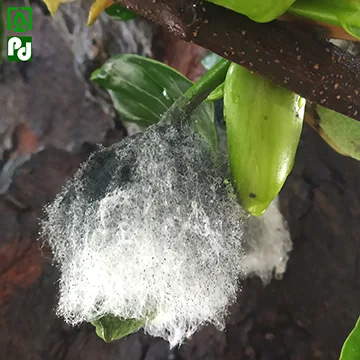Soft rot (= fruit rot = Rhizopus rot) of jackfruit
Host: Artocarpus heterophyllus (Jackfruit)
Pathogen: Rhizopus oryzae, Rhizopus artocarpi, Rhizopus stolonifer
Pathogen: Rhizopus oryzae, Rhizopus artocarpi, Rhizopus stolonifer
Distribution
Rhizopus rot is very common fungal disease of jackfruit. The disease is prevalent in the countries of tropics. Infection in flowers and fruits are more likely to occur high-rainfall areas in warm, humid and wet weather conditions. Infection at flowering stage causes total loss.
Symptoms
 |
| Jackfruit infected with Rhizopus (note the white cottony growth) |
Early symptoms appear as soft, watery brown spots on flowers and fruits. The pathogen later produces black mass of powder over white cottony mycelia on fruits. Very soon whole the fruit surface is covered with the fungal mycelia and spores. At this stage fruits is shrunken and rotten.
Symptoms can also appear on the tree and in fruits during transport and storage.
Symptoms can also appear on the tree and in fruits during transport and storage.
 |
| An infected fruit of jackfruit showing black mass of spores on cottony mycelia |
Causal organism
Rhizopus artocarpi, Rhizopus stolonifer and Rhizopus oryzae are the fungi causing soft rot of jackfruit.
Disease cycle and epidemiology
Rhizopus can survive in soil or in dead and decaying plant materials. On getting warm, wet and humid environment at the time flowering, it initiate new infection in inflorescences. The spores produced after infection brought about secondary infection and intensify the disease during same season.
Control measures
- Tree should be pruned in such a way that proper aeration is maintained.
- Organic debris around the tree should be removed.
- Water logging around the main trunk is avoided.
- At the time of flowering three spray of carbendazim or copper oxychloride @ 0.25 % or tebuconazole @ 0.05 % at the intervals of ten days should be sprayed.
Content first created on 27-01-2022
last updated on 27-01-2022
last updated on 27-01-2022





0 Comments
Leave your comments here.